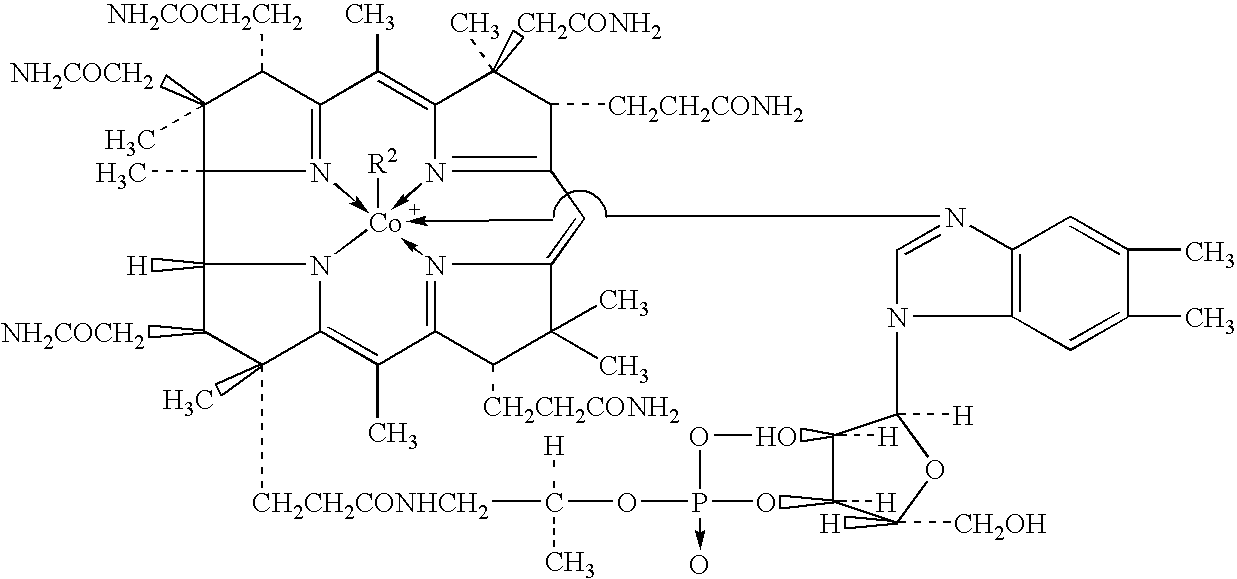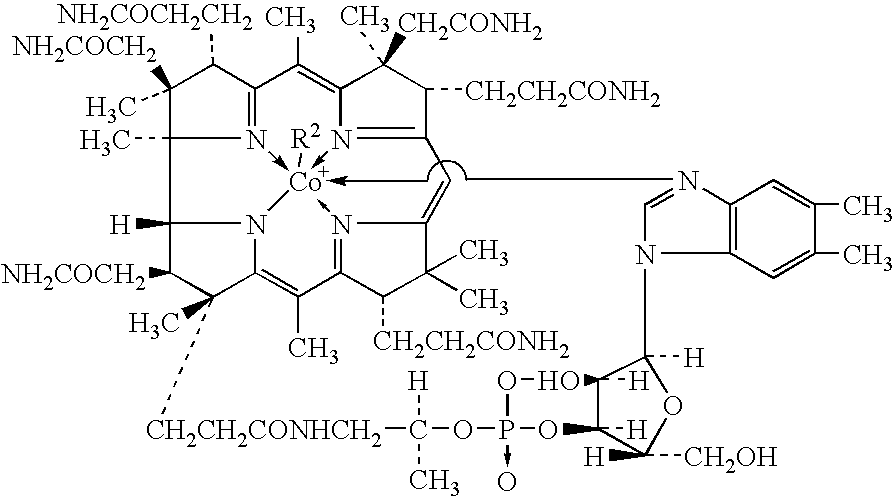Process for producing methylcobalamin
a technology of methylcobalamin and process, applied in the field of industrially excellent process for producing methylcobalamin, can solve the problems of not being commercially available, unable to be used in commercial production, and dicarboxylic acid monomethyl esters, etc., and achieves the effects of high yield, high rate and high yield
- Summary
- Abstract
- Description
- Claims
- Application Information
AI Technical Summary
Benefits of technology
Problems solved by technology
Method used
Image
Examples
example 1
Synthesis of Methylcobalamin
[0073]All the procedures in the present example were performed in the dark (under red light).
[0074]To 65 ml of ion-exchanged water were added 5 g of cyanocobalamin, 0.35 g of cobalt chloride hexahydrate, and 3.75 ml of 2-butanone. After replacing the inside atmosphere of the system with nitrogen gas, the mixture was heated in a water bath, to which an aqueous solution of sodium borohydride (2 g / 10 ml) was added dropwise under stirring at a bath temperature of 38° C. over 60 minutes. After stirring for further 30 minutes as it was, an aqueous solution of trimethylsulfoxonium bromide (1.9 g / 10 ml) was further added thereto over 30 minutes. The mixture was stirred for further 3 hours as it was, followed by stirring overnight at a bath temperature of 15° C. The resulting precipitates were collected by filtration and dried to give a crude product of the title compound. To the crude product was added a 50% acetone aqueous solution. After heating at 35° C., the ...
example 2
Synthesis of Methylcobalamin
[0080]All the procedures in the present example were performed in the dark (under red light).
[0081]To 260 ml of ion-exchanged water were added 20 g of cyanocobalamin, 1.4 g of cobalt chloride hexahydrate, and 15 ml of 2-butanone. After replacing the inside atmosphere of the system with nitrogen gas, the mixture was heated in a water bath, to which an aqueous solution of sodium borohydride (8 g / 40 ml) was added dropwise under stirring at the internal temperature of 40° C. over 70 minutes. After stirring for further 30 minutes as it was, an aqueous solution of trimethylsulfoxonium bromide (7.66 g / 40 ml) was further added thereto over 30 minutes. The mixture was stirred for further 3 hours as it was, followed by stirring overnight at a bath temperature of 15° C. The resulting precipitates were collected by filtration and dried to give a crude product of the title compound. To the crude product was added a 50% acetone aqueous solution. After heating at 35° C....
example 3
Synthesis of Methylcobalamin
[0082]All the procedures in the present example were performed in the dark (under red light).
[0083]To 390 ml of ion-exchanged water were added 30 g of cyanocobalamin, 2.1 g of cobalt chloride hexahydrate, and 22.5 ml of 2-butanone. After replacing the inside atmosphere of the system with nitrogen gas, the mixture was heated in a water bath, to which an aqueous solution of sodium borohydride (12 g / 60 ml) was added dropwise under stirring at the internal temperature of 40° C. over 2 hours. After stirring for further 30 minutes as it was, an aqueous solution of trimethylsulfoxonium bromide (11.5 g / 60 ml) was further added thereto over 30 minutes. The mixture was stirred for further 3 hours as it was, followed by stirring overnight at a bath temperature of 15° C. The resulting precipitates were collected by filtration and dried to give a crude product of the title compound. To the crude product was added a 50% acetone aqueous solution. After heating at 35° C....
PUM
| Property | Measurement | Unit |
|---|---|---|
| boiling point | aaaaa | aaaaa |
| temperature | aaaaa | aaaaa |
| temperature | aaaaa | aaaaa |
Abstract
Description
Claims
Application Information
 Login to View More
Login to View More - R&D
- Intellectual Property
- Life Sciences
- Materials
- Tech Scout
- Unparalleled Data Quality
- Higher Quality Content
- 60% Fewer Hallucinations
Browse by: Latest US Patents, China's latest patents, Technical Efficacy Thesaurus, Application Domain, Technology Topic, Popular Technical Reports.
© 2025 PatSnap. All rights reserved.Legal|Privacy policy|Modern Slavery Act Transparency Statement|Sitemap|About US| Contact US: help@patsnap.com



